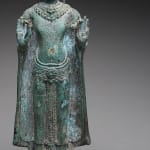Lopburi Period Khmer Bronze Buddha, 12th Century CE - 13th Century CE
Bronze
22.9 x 7 cm
9 x 2 3/4 in
9 x 2 3/4 in
CK.0118
Further images
The Khmer civilization, today embodied by the temples and ruins of Angkor, one of mankind's most astonishing and enduring architectural achievements, flourished from 802-1431 A.D. From the great citadel of...
The Khmer civilization, today embodied by the temples and ruins of Angkor, one of mankind's most astonishing and enduring architectural achievements, flourished from 802-1431 A.D. From the great citadel of Angkor, the kings of the Khmer empire ruled over a vast domain that reached from what is now southern Vietnam to Yunan, China and from Vietnam westward to the Bay of Bengal. The original city was built around the Phnom Bakeng, a temple on a hill symbolizing the mountain that stands in the center of the world according to Hindu cosmology. Successive kings enlarged the city, building other temples devoted to various Hindu deities and large reservoirs used for irrigation, which also symbolized the ocean surrounding the holy central mountain.
Today, the city of Lopburi lies within the borders of the nation of Thailand. However, the roots of this city, then known as Lavo, can be traced back to the pre-Thai Dvaravati culture more than one thousand years ago. Under the Khmer civilization, Lopburi became a provincial capital that merged Khmer artistic and cultural influences with the Indian inspired native traditions. This bronze Buddha stands on a circular base, with both hands raised in gesture of reassurance. Very much of the Khmer style, this sculpture reveals the enormous influence this neighboring kingdom had on their regional subject.
Ex. Collection British Diplomat T.C. White, MBE, collected 1970'
Ex. Belgian Art Market
Today, the city of Lopburi lies within the borders of the nation of Thailand. However, the roots of this city, then known as Lavo, can be traced back to the pre-Thai Dvaravati culture more than one thousand years ago. Under the Khmer civilization, Lopburi became a provincial capital that merged Khmer artistic and cultural influences with the Indian inspired native traditions. This bronze Buddha stands on a circular base, with both hands raised in gesture of reassurance. Very much of the Khmer style, this sculpture reveals the enormous influence this neighboring kingdom had on their regional subject.
Ex. Collection British Diplomat T.C. White, MBE, collected 1970'
Ex. Belgian Art Market











